Top 100 Video Game Designers
The Most Famous
GAME DESIGNERS from Japan
This page contains a list of the greatest Japanese Game Designers . The pantheon dataset contains 46 Game Designers, 20 of which were born in Japan. This makes Japan the birth place of the 2nd most number of Game Designers .
Top 10
The following people are considered by Pantheon to be the top 10 most legendary Japanese Game Designers of all time. This list of famous Japanese Game Designers is sorted by HPI (Historical Popularity Index), a metric that aggregates information on a biography's online popularity. Visit the rankings page to view the entire list of Japanese Game Designers.
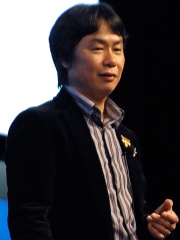
1. Shigeru Miyamoto ( 1952 - )
With an HPI of 70.17 , Shigeru Miyamoto is the most famous Japanese Game Designer . His biography has been translated into 45 different languages on wikipedia.
Shigeru Miyamoto (pronounced [mijamoto ɕiɡeɾɯ]; born November 16, 1952) is a Japanese video game designer, producer and game director at Nintendo, where he serves as one of its representative directors. He is the creator of some of the most acclaimed and best-selling game franchises of all time, including Mario, The Legend of Zelda, Donkey Kong, Star Fox and Pikmin. He is widely regarded as one of the most accomplished and influential designers in the history of video games. Born in Sonobe, Japan, Miyamoto graduated from Kanazawa Municipal College of Industrial Arts. He originally sought a career as a manga artist, until developing an interest in video games. With the help of his father, he joined Nintendo in 1977 after impressing then-president Hiroshi Yamauchi with his toys. He helped create art for the arcade game Sheriff, and was later tasked with designing a new arcade game, leading to the 1981 game Donkey Kong. Miyamoto's platform game Super Mario Bros. (1985) and the action-adventure game The Legend of Zelda (1986) helped the Nintendo Entertainment System dominate the console game market. His games have been flagships of every Nintendo video game console, from the arcade machines of the late 1970s to the present day. He managed Nintendo's Entertainment Analysis & Development software division, which developed many Nintendo games. Following the death of Nintendo president Satoru Iwata in July 2015, Miyamoto became acting president alongside Genyo Takeda until he was formally appointed "Creative Fellow" a few months later.
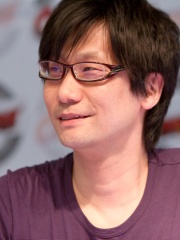
2 . Hideo Kojima ( 1963 - )
With an HPI of 68.53 , Hideo Kojima is the 2nd most famous Japanese Game Designer . His biography has been translated into 40 different languages.
Hideo Kojima (小島 秀夫, Kojima Hideo, born August 24, 1963) is a Japanese video game designer, director, producer and writer. Regarded as an auteur of video games, he developed a strong passion for action/adventure cinema and literature during his childhood and adolescence. In 1986, he was hired by Konami, for which he designed and wrote Metal Gear (1987) for the MSX2, a game that laid the foundations for stealth games and the Metal Gear series, his best known and most appreciated works. He is probably best known for his design work on Metal Gear Solid (1998) for PlayStation. He is also known for producing the Zone of the Enders series, as well as writing and designing Snatcher (1988) and Policenauts (1994), graphic adventure games regarded for their cinematic presentation. In 2005, Kojima founded Kojima Productions, a software house controlled by Konami, and by 2011, he was appointed vice president of Konami Digital Entertainment. In 2015, Kojima Productions split from Konami, becoming an independent studio. Their first game was Death Stranding, which released in 2019. Kojima has also contributed to Rolling Stone, writing columns about the similarities and differences between films and video games.
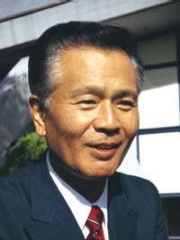
3 . Gunpei Yokoi ( 1941 - 1997 )
With an HPI of 66.19 , Gunpei Yokoi is the 3rd most famous Japanese Game Designer . His biography has been translated into 20 different languages.
Gunpei Yokoi (横井 軍平, Yokoi Gunpei, 10 September 1941 – 4 October 1997), sometimes transliterated Gumpei Yokoi, was a Japanese video game designer. He was a long-time Nintendo employee, best known as creator of the Game & Watch handheld system, inventor of the "cross" shaped Control Pad, the original designer of the Game Boy, and producer of a few long-running and critically acclaimed video game franchises, such as Metroid and Kid Icarus.
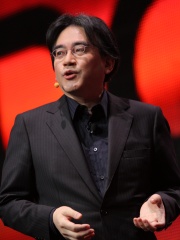
4 . Satoru Iwata ( 1959 - 2015 )
With an HPI of 65.42 , Satoru Iwata is the 4th most famous Japanese Game Designer . His biography has been translated into 39 different languages.
Satoru Iwata (Japanese: 岩田 聡, Hepburn: Iwata Satoru, December 6, 1959 – July 11, 2015) was a Japanese businessman, video game programmer, video game designer, and producer. He was the fourth president and chief executive officer (CEO) of Nintendo. He was a major contributor in broadening the appeal of video games by focusing on novel and entertaining games rather than top-of-the-line hardware. Born in Sapporo, Iwata expressed interest in video games from an early age and created his first simple game while in high school. He majored in computer science at the Tokyo Institute of Technology. In 1980, he joined the game developer HAL Laboratory while attending the university. At HAL, he worked as a programmer and closely collaborated with Nintendo, producing his first commercial game in 1983. Games to which he contributed include EarthBound and the Kirby series. Following a downturn and near-bankruptcy, Iwata became the president of HAL in 1993 at the insistence of Nintendo president Hiroshi Yamauchi and brought financial stability. In the following years, he worked in the development of the Pokémon and Super Smash Bros. series. Iwata joined Nintendo as the head of its corporate planning division in 2000. Nintendo saw growth under Iwata and, when Yamauchi retired, he became the company's president in May 2002. Under Iwata's direction, Nintendo developed the Nintendo DS and Wii game consoles, helping the company achieve financial success. As a self-declared gamer, he focused on expanding the appeal of video games across demographics through a "blue ocean" business strategy. Nintendo attained record profits by 2009, and Barron's placed Iwata among the top 30 CEOs worldwide. Iwata expanded his strategy by defining a quality-of-life product line for the Wii that evolved into a ten-year strategy to create standalone products. Later hardware such as the Nintendo 3DS and Wii U proved far less profitable than the Wii, and Nintendo's net sales fell by two thirds from 2009 to 2012; the company saw its first operating losses in 30 years during this time. Iwata voluntarily halved his salary in 2011 and 2014. In 2015, after several years of refusal, Iwata put a portion of Nintendo's focus into the rapidly growing mobile game market; a landmark partnership with mobile provider DeNA was established that March. Throughout his career, Iwata built a relationship with Nintendo fans through social media and his regular appearances in Iwata Asks and Nintendo Direct, becoming the public face of the company. In June 2014, a tumor in Iwata's bile duct was discovered during a routine physical exam. It was removed, and Iwata returned to work in October of that year. The problem resurfaced in 2015, and Iwata died at the age of 55 from its complications on July 11. Members of the gaming industry and fans alike offered tributes through public announcements and social media, and fans worldwide established temporary memorials. Iwata was posthumously awarded the Lifetime Achievement Award at the 2015 Golden Joystick Awards and the 2016 D.I.C.E. Awards.

5 . Satoshi Tajiri ( 1965 - )
With an HPI of 63.38 , Satoshi Tajiri is the 5th most famous Japanese Game Designer . His biography has been translated into 36 different languages.
Satoshi Tajiri (Japanese: 田尻 智, Hepburn: Tajiri Satoshi, born August 28, 1965) is a Japanese video game designer and director best known as the creator of Nintendo's Pokémon franchise and one of the founders, and President of video game developer Game Freak. A fan of arcade games, Tajiri wrote for and edited his own video gaming fanzine Game Freak with Ken Sugimori, before evolving it into a development company of the same name. Tajiri claims that the joining of two Game Boys via a link cable inspired him to create a game which embodied the collection and companionship of his childhood hobby, insect collecting. The game, which became Pokémon Red and Pokémon Green, took six years to complete and went on to spark a multibillion-dollar franchise which reinvigorated Nintendo's handheld gaming. Tajiri continued to work as director for the Pokémon series until the development of Pokémon Ruby and Sapphire, when he changed his role to executive producer. Tajiri has also worked for other projects including Mario spin-offs. He was also an executive producer on the live-action film Detective Pikachu.
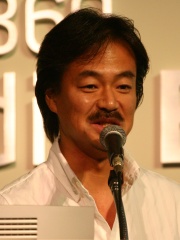
6 . Hironobu Sakaguchi ( 1962 - )
With an HPI of 61.40 , Hironobu Sakaguchi is the 6th most famous Japanese Game Designer . His biography has been translated into 27 different languages.
Hironobu Sakaguchi (坂口 博信, Sakaguchi Hironobu, born November 25, 1962) is a Japanese game designer, director, producer and writer. Originally working for Square (later Square Enix) from 1983 to 2003, he departed the company and founded independent studio Mistwalker in 2004. He is known as the creator of the Final Fantasy franchise, in addition to other titles during his time at Square. At Mistwalker, he is known for creating the Blue Dragon and Terra Battle series among several standalone titles, moving away from home consoles and creating titles for mobile platforms. Originally intending to become a musician, he briefly studied electronics and programming, joining Square as part-time employee, then later a full-time employee when Square became an independent company in 1986. He led development on several titles before helping to create the original Final Fantasy, which proved highly successful and cemented his status within the company. Following the financial failure of Final Fantasy: The Spirits Within, his debut as a film director, Sakaguchi withdrew from Square's management and eventually resigned in 2003. He continued his game career through Mistwalker, first co-developing projects through external partners and then smaller in-studio mobile projects. Born in Hitachi, Ibaraki Prefecture, he now lives in Honolulu, Hawaii where one of Mistwalker's offices is based. Several of his projects after Final Fantasy III, including Final Fantasy VII and The Spirits Within, were influenced by his thoughts on what happened after death following the loss of his mother in an accident at that time. He is also credited with direct or indirect influence on multiple Square Enix projects including Kingdom Hearts. He has received several industry honours acknowledging his contribution to and influence on video games.

7 . Toru Iwatani ( 1955 - )
With an HPI of 61.15 , Toru Iwatani is the 7th most famous Japanese Game Designer . His biography has been translated into 20 different languages.
Toru Iwatani (岩谷 徹, Iwatani Tōru, born January 25, 1955) is a Japanese video game designer who spent much of his career working for Namco. He is best known as the creator of the arcade game Pac-Man (1980).
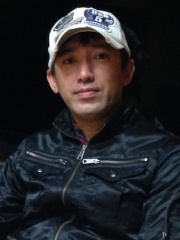
8 . Shinji Mikami ( 1965 - )
With an HPI of 61.06 , Shinji Mikami is the 8th most famous Japanese Game Designer . Her biography has been translated into 20 different languages.
Shinji Mikami (三上 真司, Mikami Shinji, born August 11, 1965) is a Japanese video game designer, director, and producer. Starting his career at Capcom in 1990, he went on to direct many of the company's biggest titles. He directed the first installment of the Resident Evil series in 1996 and the first installment of the Dino Crisis series in 1999, both being survival horror games. He returned to Resident Evil to direct the remake of the first game in 2002 and the third-person shooter Resident Evil 4 in 2005. In 2006, he directed his final Capcom game God Hand, a beat 'em up action game. Mikami worked at PlatinumGames to direct the third-person shooter Vanquish in 2010. The same year, he founded his own studio Tango Gameworks which has since been acquired by the American company ZeniMax Media. Under his studio, he directed the third-person horror game The Evil Within in 2014. He has also served the roles of producer and executive producer for many games.
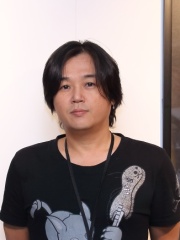
9 . Tetsuya Nomura ( 1970 - )
With an HPI of 57.94 , Tetsuya Nomura is the 9th most famous Japanese Game Designer . His biography has been translated into 22 different languages.
Tetsuya Nomura (野村 哲也, Nomura Tetsuya, born October 8, 1970) is a Japanese video game artist, designer and director working for Square Enix (formerly Square). He designed characters for the Final Fantasy series, debuting with Final Fantasy VI and continuing with various later installments. Additionally, Nomura has led the development of the Kingdom Hearts series since its inception in 2002 and was the director of the 2005 film Final Fantasy VII: Advent Children.
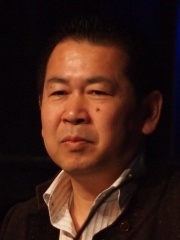
10 . Yu Suzuki ( 1958 - )
With an HPI of 57.29 , Yu Suzuki is the 10th most famous Japanese Game Designer . His biography has been translated into 22 different languages.
Yu Suzuki (鈴木 裕, Suzuki Yū, born June 10, 1958) is a Japanese game designer, producer, programmer, and engineer, who headed Sega's AM2 team for 18 years. Considered one of the first auteurs of video games, he has been responsible for a number of Sega's arcade hits, including three-dimensional sprite-scaling games that used "taikan" motion simulator arcade cabinets, such as Hang-On, Space Harrier, Out Run, and After Burner, and pioneering polygonal 3D games such as Virtua Racing and Virtua Fighter, which are credited with popularizing 3D graphics in video games, as well as the critically acclaimed Shenmue series. As a hardware engineer, he led the development of various arcade system boards, including the Sega Space Harrier, Model 1, Model 2, and Model 3, and was involved in the technical development of the Dreamcast console and its corresponding NAOMI arcade hardware.In 2003, Suzuki became the sixth person to be inducted into the Academy of Interactive Arts and Sciences' Hall of Fame. IGN listed him at #9 in their Top 100 Game Creators of All Time list. In 2011, he received the Pioneer Award at the Game Developers Choice Awards.
Top 100 Video Game Designers
Source: https://pantheon.world/profile/occupation/game-designer/country/japan
Posted by: herreralefterim.blogspot.com


0 Response to "Top 100 Video Game Designers"
Post a Comment